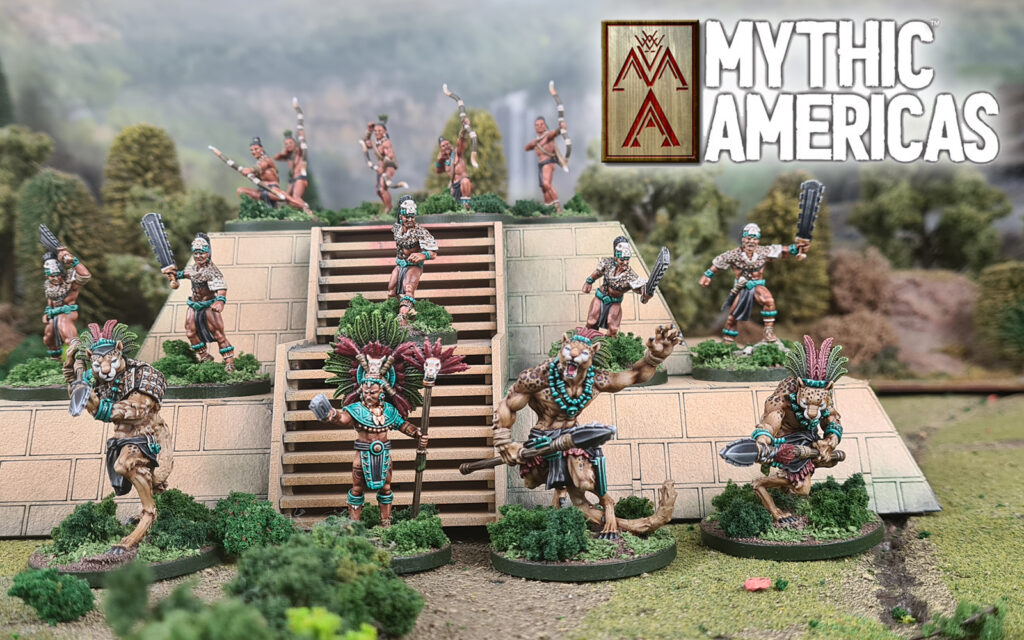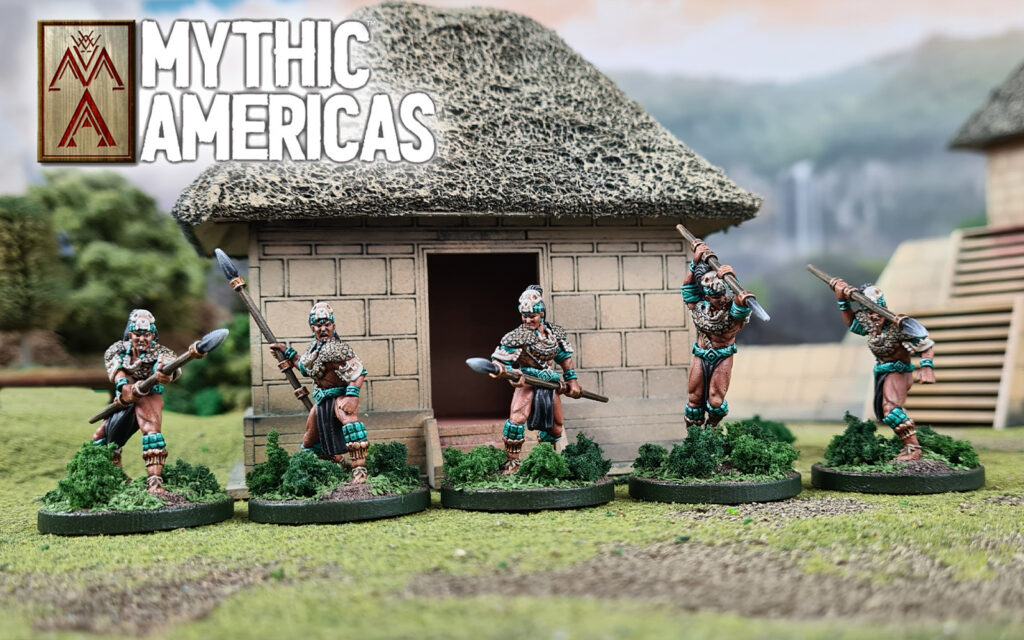The Maya Warband are the fourth and final faction represented in the core Mythic Americas rulebook, and with a glorious range of miniatures (and one not so miniature!) set to pounce onto tabletops, we’re briefly exploring the history of Maya culture and how that translates on the tabletop within Mythic Americas.
Developed in partnership between Warlord Games and Mythicos Studios, Mythic Americas takes players on a journey through American folklore, using the incredible Warlords of Erewhon engine to power lightning-fast skirmish games between warbands of the Mythic Americas!
A Brief History of the Maya
The Maya identity goes back a little more than 4,500 years, when a group of Proto-Mayan speakers settled in the region of Altos Cuchumatanes, in what is modern-day Guatemala. Over time this group of people became one of the most prosperous and powerful empires in Mesoamerica. Between A.D. 250 and 600, major Maya cities consolidated their power and as the surrounding regions saw the rise of many newer ones. It was a period of growth and development based on a social, economic, and political organization led by a noble ruler, as the guiding force, to all levels of the community. Although this was a period of significant expansion, it was not until between A.D. 600 and 800, that Maya culture attained its greatest splendour. This period saw the growth and development of the most famous and imposing cities, such as Tikal and Caracol, in Guatemala; Izamal, Aké, Uxmal, and Ek Balam, in Yucatán; Xunantunich, Lamanai, and Altun-Há, in Belize; and Copán, in Honduras.
When the term ‘Maya’ is mentioned, most people conjure up images of the complex cities, giant temples emerging through the green rainforest and thousands of hieroglyphic texts providing the names, deeds, and rites of Maya kings and queens. From the Northern tip of the Yucatan Peninsula to what is now modern-day El Salvador the Maya created a formidable society that still influences the region to this day.
The Maya culture was one of inherited nobility. Leaders of large cities could exact tribute from smaller communities, command men to build large public works, or enlist men from subordinate villages to defend them whenever enemies attacked or assist with warfare against rival cities. Securing or reassigning social and/or political status was typically achieved by evoking ancestors, supernaturals, animals, architecture, history, and memories used to actively link individuals to a past, a powerful (or important) lineage, an apical ancestor of a kin group, or a significant built landscape.
Though long-term warfare was seemingly limited during the time of the Maya, militarism was clearly a very prevalent and important ritualistic activity. The emphasis placed on territorial control gave rise to feuds between rulers of neighbouring cities and often led to raids on enemy camps. The need for sacrificial victims or slaves may also have been a reason for unannounced attacks. At some sites defence methods such as walls and earthworks to barricade the city have been discovered. During the Classic Period guerrilla warfare techniques included the use of wooden palisades, thorny entanglements, and deadfalls. The Mayan warriors were equipped with spears, wooden clubs, flint knives, and shields for hand-to-hand combat. As they developed their methods of warfare they introduced atlatls, or spear-throwers to the Maya arsenal along with obsidian blade edged clubs known as macuahuitl. The primary goal of Maya warfare was to capture, rather than kill, as many of the enemy as possible. Captives of elite status typically became subjects for human sacrifice, while commoners were sentenced to slavery.

How Do They Play?
The Maya are an elite, well-trained force with warbands that usually muster fewer models. They rely on psychology rather than brute strength to stand up against more numerous foes. This comes in the form of pins making it harder for the opposing units to follow orders. By modifying the command check, the enemy wastes precious activations to Rally or risks being routed or even broken.
The Maya Command value is above average, signifying the disciplined nature and exceptional training of the Maya force. Their higher armour can keep them in combat past round one which enables them to be more dangerous with the Vengeful special rule. Maya soldiers can be exceptionally terrifying on the battlefield and most units have the Cause Fear and Vicious special rules which can impose extra pins from combat.
Cause Fear– Whenever a Maya unit with Cause Fear wins a round of combat, add one pin to the losing unit before break tests are taken. Units that Cause Fear, Dread or Terror and any monstrosity are immune to Cause Fear.
Vicious– Any attack rolls of ‘1’ cause a pin, regardless if the wound was saved or not.
The Maya Warband Starter Army
The Maya Warband Starter Army contains the core elements of a Mayan warband, led by a Halach Uinic Warlord, capable warriors in both close and ranged combat, and boasting the savagery of terrifying werejaguars. This is an ideal starting point for those new to collecting the Maya, or Mythic Americas itself.
The Maya are an elite force that can call upon extremely capable warriors, powerful heroes, and fearsome monstrosities. Read on to find out a little more about what each brings to the tabletop in a little more detail :
Heroic Miniatures
Halach Uinic Warlord
The Halach Uinic holds all religious, civil, and military power in Maya society. Leading his council of Almehenob Nobles into battle, the Halach Uinic is both a cunning tactician and formidable fighter.
Ah Kin Priestess
Ah Kin, the sun god, is venerated by the Maya and Ah Kin Priestesses ritually sacrifice humans to him at dawn, carving out the still beating heart in tribute. Moreover, they use terrifying blood magic in battle causing havoc among the enemy.
Warriors
Almehenob Nobles
Wealthy Almehenob Nobles are fiercely loyal to the Halach Uinic. Their position, power and privilege gives them access to the best weapons and strongest armour, which they train with ceaselessly, shaping them into some of the most formidable mortal warriors.
Calakmal Warriors
Wearing fierce trophies and ornaments, the Calakmal Warriors of the Maya are a fearsome sight, almost demonic. Raiding and fighting for their masters, these warriors often wield macuahuitl, which can smash bone, tear skin and leave horrific damage.
Tikal Archers
Tikal Archers fight alongside the Calakmal Warriors, shooting waves of vicious arrows into the enemy. Some are armed with the powerful atlatl spear-thrower, which is capable of piercing through even the strongest armour.
Warrior Beasts & Swarms
Werejaguars
Maya shamans who were deemed to have a stronger essence (or nagual) could initiate and sustain an interaction with the detached soul. In some cases, evil magic aimed at displacing and harming the soul is carried out and was considered to lead to sickness and required shamans to perform curing ceremonies to avoid death of the receptacle-body. It is believed by some that this nagual could be so powerful its spirit could allow men to shift forms into creatures like jaguars, taking on their speed and power.
In Mythic Americas, werejaguars live among the Maya as humans, all the while stalking the dark rainforests, hunting in their jaguar form. When war comes, they use their speed, ferocity and savagery to dart across the battlefield, striking where the enemy least expects before resuming their human form.
Alux
The Maya had a connection to a fey creature known as the Alux. The Alux protect plantations, cornfields and properties. To obtain its favours, a farmer makes a request to the shaman, who uses mud from the land, and a few drops of the land owner´s blood to generate a strong connection between them. The creation process takes seven weeks. Once the process is over, the shaman indicates the name of the master and brings the Alux to life through offerings and prayers, and then places him in a strategic place to become the guardian. If the master dies, these mischievous pixies go to the service of the god of corn, Yum K’aax, and if the property they cared for is occupied by a new owner, the Alux will become mischievous until the new owner, tired of their acts, offers them food and prayers.
In game, Alux act as swarms. Using cunning, trickery and illusion, they harass and frighten the enemy. Even the most heavily armed warrior can fall prey to their mind-bending tricks, sowing fear and discord in even the most disciplined.
Monstrosity – Camazotz
A sinister figure, the prince of the Maya legions of darkness, is the bat-god, Zotzilaha Chimalman, who dwelt in the ‘House of Bats,’ a gruesome cavern on the way to the abodes of darkness and death. He is undoubtedly a relic of cave worship. This deity is alluded to in the Popol Vuh, under the name Camazotz, in close proximity to the Lords of Death and Hell, attempting to bar the journey of the hero-gods across these dreary realms and claiming the head of the Hero Hunahpu as he attempted to pass through Xibalba.
In game, the utterly terrifying Camazotz, or Death Bat, is a divine creature of nightmares. It rises from the underworld at the behest of Mayan priests to aid them in war. Silent as the night air, it strikes without warning and those who witness its baleful presence cower in terror as it shreds its victims to tatters. The miniature is huge, looming over most of its foes on the battlefield, and is a fine centrepiece model for a collection whether wargaming or not.
The Complete Maya Warband
This bundle gives you one of every box set (except the starter warband) available to the Maya in Mythic Americas, giving the ultimate flexibility in tabletop tactics, army composition and pure visual variety and flair. A full Mythic Americas warband looks truly resplendent on the tabletop – the miniatures lending themselves to particularly vibrant, striking colour palettes. For even better value, you’ll get the astounding Werejaguars unit completely free.




















